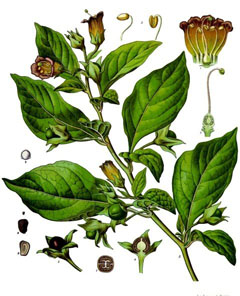The Deadliest Nightshade
By Audrey Stallsmith

No, no, go not to Lethe, neither twist
Wolf's-bane, tight-rooted, for its poisonous wine;
Nor suffer thy pale forehead to be kiss'd
By nightshade, ruby grape of Proserpine. . .
John Keats--"Ode on Melancholy"
Deadly nightshade both fascinates and repels. It can be a seductive plant with its purple bells and black berries. But those "shades of night" imply its sinister character.
It has always been one of the most dangerous plants for children, who find its sweet but deadly "cherries" irresistible. So you probably don't want nightshade in your landscape. But it is related to more innocent garden staples such as tomatoes, potatoes, and peppers.
Native to Europe, Asia, and now to the U.S. too, the perennial plant generally grows in limey, shaded soil where it can reach a height of five feet. It produces its bells for most of the summer, with its originally red berries ripening to black in September.
Its official name, Atropa belladonna, derives from Atropos, one of the mythological fates who supposedly cuts the threads of life. Belladonna actually means "beautiful woman," as the plant can allegedly metamorphose into an evil enchantress. But real-life women have also used it to make themselves more attractive, as atropine dilates the pupils.
Because the plant is so poisonous, deadly nightshade has also been known as sleepy nightshade, devil's cherries, beautiful death, or dwale. The latter word may derive from the Scandanavian dool ("delay" or "sleep") or from the French deuil ("grief"), either of which sounds ominous enough! And, in the Language of Flowers, nightshade stands even more chillingly for "silence."
"A peculiar symptom in those poisoned by belladonna," notes Mrs. Grieve in A Modern Herbal, "is the complete loss of voice, together with frequent bending forward of the trunk and continual movements of the hands and fingers."
Other signs of poisoning include double vision, dizziness, delirium, rage, thirst, fever, nausea, vomiting, headache, and--of course, extremely dilated pupils. This hallucinogen was probably one of the plants that gave witches the delusion that they could fly.
"This kind of Nightshade," Gerard warns in his more ancient Herball, "causeth sleep, troubleth the mind, bringeth madness if a few of the berries be inwardly taken, but if more be given they also kill and bring present death. If you will follow my counsell, deale not with the same in any case, and banish it from your gardens and the use of it also, being a plant so furious and deadly. . ."
As he points out, children have most frequently been the victims of nightshade, since it takes far fewer berries to poison them. The Cottager's Monthly Visitor of 1846 tells of one John Hillyard who hawked in London what he claimed were "nettle berries." Though a Maria Parker told him she'd never heard of nettle berries, she still purchased some and made a tart, as a consequence of which her husband and a visiting little boy died.
Several other people who had eaten berries from the same seller, including Maria herself, got very sick but survived. He was convicted of manslaughter and jailed. And rightly so, since nightshade plants are not at all similar to nettles--and the latter definitely don't have berries!
The fact that only a couple of the victims died showed how unpredictable plant poisons can be. But there is a legend that the real-life Macbeth once used nightshade to stupefy a Danish army so his own men could slaughter them. And aristocratic ancient Romans, who rather made a hobby of doing away with friends and family, are said to have favored this particular poison. Although I have grown quite a number of other toxic plants, I've decided that this one probably isn't worth the risk.
Nightshade extracts are still used in some modern medicines, especially to control mucous, relieve spasms, dilate the pupils, and as an antidote for other poisons. But those prescriptions must be carefully concocted by professionals, as there is always the danger of this "herb" putting the patient permanently to sleep. So it's definitely not the sort you can use for home remedies!
Plants, of course, are not to blame for the uses people make of them. In Adam Bede, George Eliot writes of the nightshade being in its "yellow and purple glory." So it might have made an innocent enough ornamental if not for the "shadiness" of human nature!
Atropa belladonna image is from Kohler's Medizinal-Pflanzen, courtesy of Wikipedia.








